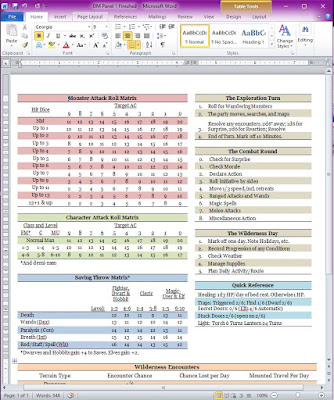This analysis refers to my own Monster table which I talk about in my previous post.
Here is a link to the Excel spreadsheet. It is definitely a work in progress, but most of the dungeon tables are done.
Mathematically, only about 3% of overland encounters will be with Men. This seems very low. So I think I will add in a preliminary roll for overland play: on 1d6, a result of 1 goes directly to the Men subtable (not to be confused with the Man-Type table which includes all the common Demi-men as well as some normal-type monsters.)
Here is a link to the Excel spreadsheet. It is definitely a work in progress, but most of the dungeon tables are done.
 |
| Does not appear on these random tables! |
Mathematically, only about 3% of overland encounters will be with Men. This seems very low. So I think I will add in a preliminary roll for overland play: on 1d6, a result of 1 goes directly to the Men subtable (not to be confused with the Man-Type table which includes all the common Demi-men as well as some normal-type monsters.)
The Men subtable will have the several kinds of Men of course. That means 20% of overland encounters will be with bandits, brigands, dervishes, whatever.
This feels better to me. The world is strange but it should be a world of Men.
UPDATE:
After hearing from some of the fellows in the several D&D-themed G+ groups, I think the proper number should be 1-3 on a d6, or just shy of 53% (plus the 3% from the proper monster tables.) Some fellows said higher and some lower, but they got me thinking about the right answer for me, and that's what I was hoping for. Thanks, guys!
That makes Men the creature of predominant number in the Realm and keeps things feeling a little more Medieval-fantasy and not weird fantasy. Nothing wrong with weird, but it's not what I'm going for.
Something else that just came to me is I want Cyclopes and Titans on my Giants subtable so I'm going to go do that too.
UPDATE:
After hearing from some of the fellows in the several D&D-themed G+ groups, I think the proper number should be 1-3 on a d6, or just shy of 53% (plus the 3% from the proper monster tables.) Some fellows said higher and some lower, but they got me thinking about the right answer for me, and that's what I was hoping for. Thanks, guys!
That makes Men the creature of predominant number in the Realm and keeps things feeling a little more Medieval-fantasy and not weird fantasy. Nothing wrong with weird, but it's not what I'm going for.
Something else that just came to me is I want Cyclopes and Titans on my Giants subtable so I'm going to go do that too.






















